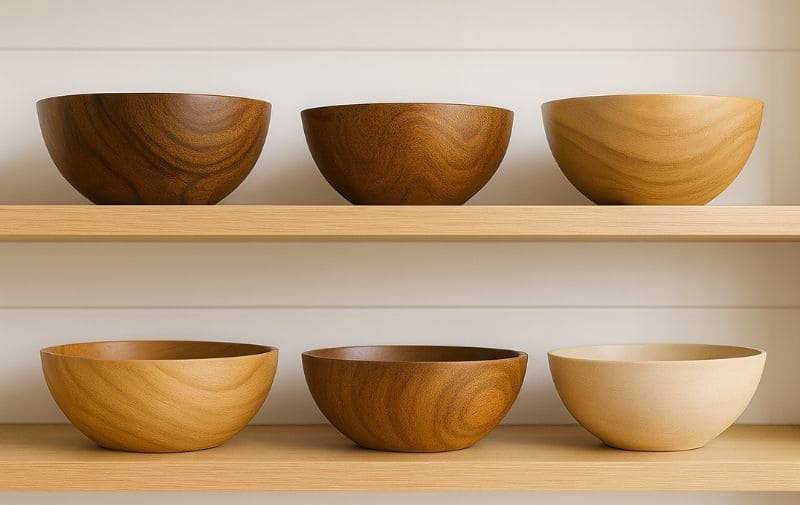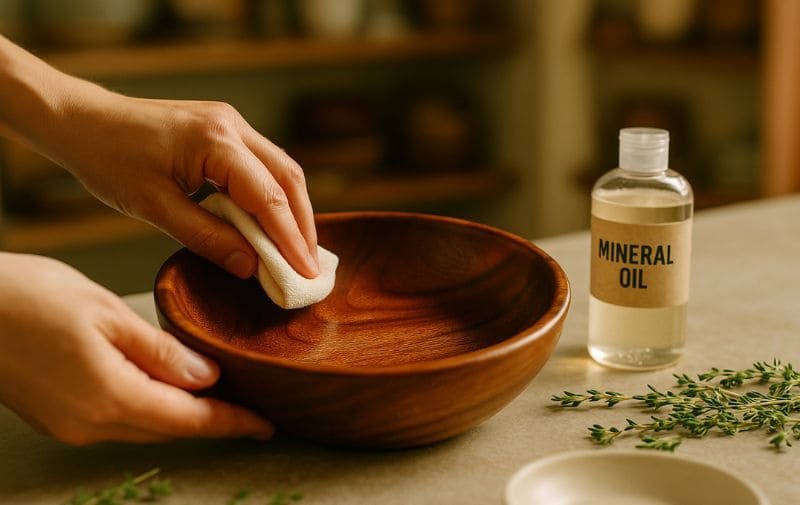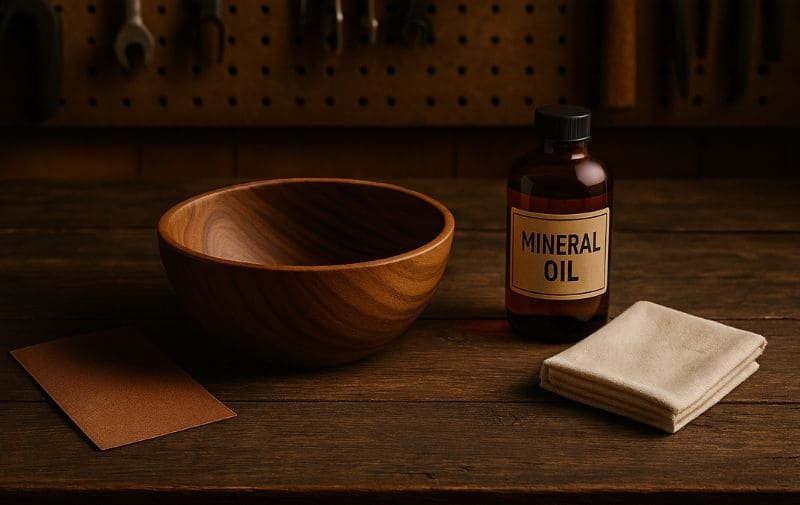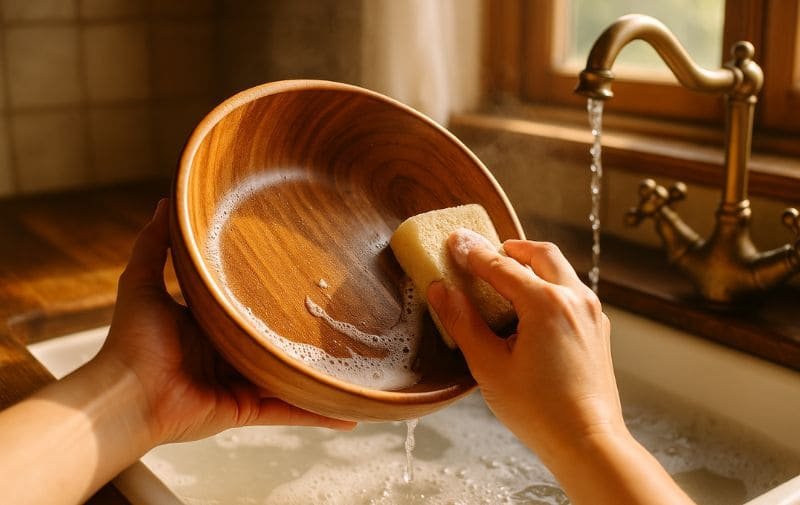You own a beautiful wooden salad bowl, a piece of natural art that brings warmth to your table. But after a few uses, you’re hesitant. It looks a little dull, maybe it has a faint smell, and you’re terrified of ruining it. How do you clean it without causing it to crack or warp?
To clean a wooden bowl, wash it quickly by hand with mild soap and warm water, then dry it immediately and thoroughly with a towel. For long-term care, never put it in the dishwasher or soak it, and periodically season it with a food-safe, non-rancid oil like mineral oil.
That’s the basic ritual, but a truly well-loved wooden bowl deserves a little more understanding. As someone who works with these materials daily, I can tell you that keeping your bowl beautiful for generations is simple once you learn its secrets. The most important secret isn’t about the wood itself, but about its protective finish.
Last Updated: Aug 10th. 2025 | Estimated Reading Time: 19 Minutes

First, The Secret You Must Know: Are You Cleaning Wood or a Finish?
This is the one thing most guides miss, and it changes everything. You aren’t just cleaning wood; you are cleaning the bowl’s finish, and different finishes have different needs. Before you do anything else, you need to identify what kind of bowl you have.
The care your wooden bowl needs depends entirely on its finish. A bowl with a porous oil finish requires regular seasoning, while a bowl with a sealed film finish is cleaned more like a standard dish.
Figuring this out is simple. Run your finger over the surface. Does it feel like natural wood, maybe with a slight oily or waxy texture where you can feel the grain? That’s a penetrating oil or wax finish. Does it feel perfectly smooth, slick, and almost like plastic? That’s a film finish like lacquer or varnish. This guide focuses primarily on the much more common oil and wax finished bowls, which are designed for regular food use.
Understanding Wooden Bowl Finishes
| Type of Finish | How It Feels | What It Means for You |
|---|---|---|
| Food-Safe Oil Finish | Natural, matte, feels like raw wood. May feel slightly oily when new. | Most Common. The wood is porous and relies on soaked-in oil for protection. It needs regular re-seasoning to stay healthy. |
| Beeswax / Hardwax Finish | Silky smooth, has a soft, low-sheen luster. | Excellent Protection. The wax fills the wood’s pores, creating a more water-resistant barrier. Requires less frequent seasoning than an oil finish. |
| Film Finish (Lacquer) | Slick, glossy, almost plastic-like. | Low Maintenance. The wood is sealed by a protective film. It’s easy to wash but can chip or peel over time, and it loses the natural wood feel. |
What Are the 3 Golden Rules of Wooden Bowl Care?
No matter what kind of wood your bowl is made from, there are three absolute, unbreakable rules. Following these will prevent 99% of all potential damage.
To protect your wooden bowl, you must never put it in the dishwasher, never let it soak in water, and always dry it completely and immediately after washing
Golden Rule #1: Why the dishwasher is wood’s worst enemy?
The combination of extreme high heat, harsh detergent chemicals, and a prolonged wet/dry cycle is a death sentence for wood. It will strip away the protective oil finish, cause the wood grain to swell and roughen, and can cause the bowl to crack or delaminate—often in a single cycle.
Golden Rule #2: Why you should never, ever soak a wooden bowl?
Letting a wooden bowl sit in a sink full of water is the second-fastest way to destroy it. The wood will absorb water unevenly, causing it to swell in some areas and not others. This internal pressure leads to warping (the bowl losing its shape) and eventually splitting along the grain.
Golden Rule #3: Why drying immediately is the most critical step?
Even after a quick rinse, letting a bowl air dry is a mistake. Water droplets left to sit on the surface will slowly penetrate the wood’s finish, leading to dull, gray water spots and a blotchy appearance over time.
How Do You Properly Clean a Wooden Bowl After Use?
Now that you know the rules, let’s walk through the simple daily cleaning ritual. Yes, you absolutely should wash your bowl after every salad. It’s easy, fast, and safe when done correctly.

The best way to clean a wooden bowl is with a soft cloth, a small amount of mild dish soap, and warm water. The key is to be quick, gentle, and thorough with your drying.
Think of it as a quick rinse-and-dry, not a deep scrub. The goal is to remove food residue without stripping the protective oil finish you’ve worked to build up.
The 3-Step Daily Cleaning Method
- Step 1: Rinse Quickly. As soon as you’re done using it, take the bowl to the sink and rinse it with warm water to remove any loose salad dressing or crumbs. Don’t let food sit in it for hours.
- Step 2: Wash Gently. Apply a single drop of mild dish soap to a soft sponge or cloth. Gently wash the interior and exterior of the bowl. Never use abrasive scrubbers or steel wool, as these will scratch the wood’s surface.
- Step 3: Rinse and Dry Immediately. Rinse the bowl thoroughly under warm water to remove all soap residue. Then, grab a clean, absorbent towel and dry the bowl completely—inside and out. Don’t leave any moisture behind. Once dry, you can put it away.
Insider Tip: Place a small hook inside a cabinet door to hang your dish towel. Having a dedicated, always-dry towel on hand makes it easy to follow Rule #3 every single time.
How Do You Fix Common Wooden Bowl Problems?
Even with great care, you might run into a few issues, especially with a vintage bowl or one that was accidentally mistreated. Don’t worry, most common problems are fixable.
That sticky residue on an old bowl is actually rancid oil, not dirt. It can be removed with a solvent or vigorous scrubbing. Odors and stains can be treated with natural cleaners like lemon, vinegar, or baking soda.
Let’s break down how to tackle the most frequent complaints.

The Problem: A Gross, Sticky Residue
That tacky, gummy feeling is the #1 issue with older wooden bowls. It’s caused by seasoning the bowl with the wrong kind of oil—like olive, canola, or other cooking oils—which have spoiled and hardened over time. Soap and water won’t cut it.
- The Gentle Method: Try using a degreasing dish soap (like Dawn) and a non-abrasive scrub pad. Scrub the sticky areas firmly. This may take some effort but can often remove a light layer of rancid oil.
- The Professional Method: For truly stubborn residue, you need a solvent. In a well-ventilated area and with gloves on, dampen a clean cloth with food-grade mineral spirits. Gently rub the sticky sections. The solvent will dissolve the rancid oil almost immediately. Once the stickiness is gone, you must wash the bowl thoroughly with soap and water to remove all solvent residue, dry it, and then immediately proceed to the restoration and seasoning step, as the wood will now be completely stripped and vulnerable.
The Problem: Stubborn Smells (Garlic, Onion)
A great salad often leaves behind a strong aroma. To neutralize it, you can use a mild acid or a base.
- Vinegar Solution: Mix a solution of one part white vinegar to five parts water. Wipe the inside of the bowl with this mixture, let it sit for a minute or two, then rinse, wash with mild soap, and dry completely.
- Lemon Juice: Cut a lemon in half and rub the cut side all over the interior of the bowl. The citric acid will help neutralize odors. Let it sit for a few minutes before rinsing, washing, and drying.
- Baking Soda Paste: For very persistent smells, make a thick paste of baking soda and water. Smear it inside the bowl and let it sit for 15-20 minutes before scrubbing it out and washing normally.
The Problem: Stains from Berries or Dressing
Dark foods can sometimes leave stains. For a specific spot, you can try rubbing it with a cut lemon and some coarse salt. The salt acts as a gentle abrasive and the lemon as a mild bleaching agent. For more widespread discoloration or deep-set water stains, your best option is to restore the bowl by sanding it lightly
| Problem | The Real Cause | The Professional Solution |
|---|---|---|
| A Gross, Sticky Residue | Rancid Cooking Oil. Not leftover dressing! Using olive, vegetable, or other cooking oils for seasoning creates a polymerized, gummy layer. | Mineral Spirits. This solvent dissolves the rancid oil. Gently rub with a cloth dampened in spirits, then wash, dry, and immediately re-season. |
| Stubborn Smells (Garlic, Onion) | Porous wood has absorbed the food’s aromatic oils. | Baking Soda Paste. Mix baking soda with a little water to form a paste. Coat the inside of the bowl, let it sit for 15 minutes, then rinse and dry. |
| Dark Stains (Berries, etc.) | Strong pigments from food have soaked into the wood fibers. | Lemon & Salt Scrub. Cut a lemon in half, dip it in coarse salt, and gently scrub the stained area. The acid and abrasive action will lift the stain. Rinse and dry immediately. |
| The Bowl Looks Dry & Faded | The protective oil finish has worn away from use and washing. The wood is “thirsty.” | Deep Re-Seasoning. The bowl needs to be fed with the correct food-safe oil to restore its protection and luster. |
How Do You Properly Restore and Season Your Bowl?
“Seasoning” is the most important part of long-term care. It’s the process of feeding your bowl the oil it needs to stay hydrated, protected, and beautiful.
You season a bowl by applying a food-safe, non-rancid oil, like mineral oil or a specialized bowl conditioner. This oil soaks into the wood, protecting it from moisture and preventing it from drying out and cracking
The Best & Worst Oils for Your Wooden Bowl
Using the wrong oil is the most common mistake. Cooking oils like olive, vegetable, corn, or walnut oil will go rancid over time, creating that sticky mess we just fixed.
| Oil Type | Recommendation | Why? |
|---|---|---|
| Food-Grade Mineral Oil | ✅ Highly Recommended | The industry standard. It’s inexpensive, easy to find (in drugstores or hardware stores), and will never go rancid. It’s completely inert and food-safe. |
| Beeswax / Bowl Butter | ✅ Excellent Choice | These are typically a mix of mineral oil and beeswax/carnauba wax. The wax adds an extra layer of water resistance and a beautiful, silky feel. |
| Fractionated Coconut Oil | ✅ Good Alternative | The long-chain triglycerides have been removed, so it stays liquid and won’t go rancid like regular coconut oil. |
| Olive, Vegetable, Walnut, Canola Oil | ❌ AVOID | These are organic, non-drying oils that will spoil and go rancid over time, leaving your bowl sticky, smelly, and unsanitary. |
Step-by-Step Guide to Seasoning
- Start Clean & Dry: Ensure your bowl is completely clean and dry.
- Warm the Oil (Pro Tip): Place your bottle of mineral oil or bowl butter in a cup of hot tap water for a few minutes. Warm oil penetrates the wood fibers much more deeply and effectively.
- Be Generous: Pour a liberal amount of the warm oil into the bowl. Don’t be shy.
- Massage It In: Using your bare hands or a soft, lint-free cloth, massage the oil into every surface of the bowl—inside, outside, and the rim. This is the most satisfying step!
- Let It Soak: Let the bowl sit for at least one hour. For a very dry or newly restored bowl, let it soak overnight.
- Buff It Dry: This is key. Use a clean, dry cloth to wipe away all of the excess oil. Keep buffing until the bowl’s surface feels nourished and silky, not greasy or wet.
Can You Clean a Wooden Bowl with Vinegar or Lemon?
Yes, but think of them as tools, not daily cleaners. Both vinegar and lemon juice are acidic and can be used for specific tasks, but they can damage the finish if used improperly.
- For Disinfecting & Odors: A quick wipe-down with a cloth dampened in a 50/50 solution of white vinegar and water is a great way to sanitize the bowl or remove strong smells. Rinse and dry immediately afterward.
- For Stains: As mentioned, a lemon and salt scrub is effective for lifting berry or wine stains.
The Caveat: Never let vinegar or lemon juice sit on the wood for an extended period. Their acidity can break down the oil finish and even bleach the wood itself.

Conclusion
Caring for a wooden bowl isn’t complicated; it’s a ritual. By following three simple rules—wash gently, never soak, and always dry—and by feeding it the right oil monthly, you will ensure your bowl remains healthy, beautiful, and a treasured part of your family’s meals for generations
Your Wooden Bowl Care FAQ: Answered
1. I accidentally put my wooden bowl in the dishwasher. Can it be saved?
Maybe. If it hasn’t cracked or warped badly, you can try to save it. The heat and detergent have stripped it bare. Let it dry completely for a day or two, then lightly sand any fuzzy, raised grain with very fine-grit sandpaper (400-grit). Then, perform a deep re-seasoning, possibly letting it soak in warm mineral oil overnight.
2. How often should I be oiling or seasoning my bowl?
A good rule of thumb is about once a month for a regularly used bowl. However, the bowl will tell you when it’s thirsty. If it starts to look dry, pale, or a patch doesn’t bead water anymore, it’s time for a coat of oil.
3. What’s the real difference between mineral oil and butcher block oil?
Food-grade mineral oil is a single, pure ingredient. “Butcher block oil” or “bowl butter” is typically a proprietary blend of mineral oil with added waxes like beeswax or carnauba wax. Both are excellent. The added wax provides slightly better water resistance and a silkier finish.
4. Is a wooden bowl really sanitary for serving food?
Yes. Studies have shown that wood, particularly when properly seasoned, has natural antimicrobial properties. A clean, well-maintained wooden bowl is perfectly sanitary for serving salads and other foods. The key is cleaning it promptly and keeping it seasoned.
5. My wooden bowl has a shiny, lacquered finish. Should I oil it?
No. If your bowl has a hard, slick film finish (like lacquer or polyurethane), the oil cannot penetrate it. You should simply wash it with mild soap and water and dry it. Oiling will just make the surface greasy. Care for it as you would any other sealed dish, but still keep it out of the dishwasher and microwave.
6. Can I use my wooden salad bowl for hot soup?
It’s not recommended. Extreme and sudden temperature changes can cause the wood to expand or contract rapidly, potentially leading to cracks. Wooden bowls are best suited for room temperature or cold foods.
Recommended:



